Today’s semi-automatic rifle is more accurate and easier to care for than ever before. They’re also a lot of fun. The most popular platform continues to be the AR-15, but not everyone is satisfied with chambering 22-caliber ammunition. The fact is that a number of calibers are coming (and going) in an attempt to increase stopping power. In this test we will evaluate four semi-automatic rifles chambered for 308 Winchester. The increase in power is significant, and 308 is a time-tested widely available cartridge. Our test rifles were the $2095 DSA SA58 21-inch Bull Barrel, the $1821 FNH USA FNAR, the $2363 Springfield Armory M1A Loaded, and the $1969 Fulton Armory UPR rifle, an AR-style gun is based on Fulton’s Titan II lineup. Each one of our rifles, with the exception of the FNAR, was available with options from a menu of upgrades, so we took advantage of this when we could. The FN rifle does come with modular components to help suit the needs of different shooters.
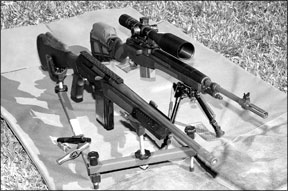
To test our rifles we visited American Shooting Centers in Houston. Our first shots from each rifle were to sight in a Nightforce 5.5-22x50mm NXS scope. We chose the Nightforce scope because of its clarity and versatility. It had a mil-dot reticle with see-through mil-dots plus illumination on demand. Pulling outward on the left-side focus supplied an ideal level of illumination. The reticle remained sharply defined at all times.
Because we would be flipping this one scope from rifle to rifle, we needed a system that offered quick, strong, and precise re-mounting. We could have gone with a quick-release unit, but instead we chose Nightforce rings that attached to the base via a half-inch hex nut. We used a 65-inch-pound Seekonk calibrated torque wrench with T-handle to make sure the unit was properly locked into place each time. The repeatable zero of the Nightforce scope made sighting in a simple mechanical chore. Suggested retail prices for the rings and scope were $160 and $1700, respectively.
Once we were sighted in, we recorded five-shot groups from the 100-yard line. Support was provided by Caldwell’s 7-rifle rest. This unit was a light skeletal structure that supported the rifle beneath the buttstock and the fore-end. The 7 design left plenty of room for the shooter to assume a natural shooting position with the benefit of additional mechanical support. We also fired with a Caldwell Rock Jr. beneath the fore-end with a beanie bag squeezed beneath the buttstock.
Each of our guns was designed as a battle rifle with available high-capacity magazines, so we didn’t always take time to let the guns cool between groups. But we did take note of any difference in performance due to barrel temperature. American Shooting Centers offers target boards set out as far as 600 yards. But long-range shooters must first qualify at the 300-yard line. We decided that we’d pick the best ammunition for each rifle and try shooting them from the 300-yard line prone with bipod attached. With our Nightforce scope turned up to 22X, using a spotting scope proved unnecessary.
Our test ammunition consisted of 168-grain Federal Gold Medal Match boattail hollowpoints and two boattail hollowpoints from Black Hills Ammunition weighing 168 grains and 175 grains, respectively. Over our test period we suffered through heavy winds, which we monitored with a Kestral 4000 Weather Station. Testing for function, accuracy and versatility from four different platforms, here is what we learned.
FNH USA FNAR Light Barreled Rifle No. 3108929250 308 Win., $1821
Weighing just less than 8 pounds, our FNAR was the lightest rifle in our tests. The heavy-barrel version of this same rifle was listed on the www.FNH-USA.com website as weighing about one additional pound. The FNAR featured a black synthetic stock with pistol grip and Monte Carlo stock. Three comb pieces and three buttpads were supplied, so height of comb and length of pull could be altered. In addition, a set of shims were supplied so that the angle of the buttstock could also be changed. But we tested the rifle as delivered. A 10-inch-long scope rail was mounted above the receiver, and accessory rails were attached to the fore-end on each side plus on the bottom. The bottom rail also supplied a fixed stud for attaching a sling.
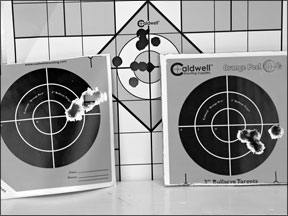
The buttstock and pistol grip were molded as one piece. The fore-end was separate. The trigger group was held in place by three Allen screws. The safety was located at the lower rear corner of the trigger guard, moving off Safe from right to left. The magazine well was located much further forward than typically found on an AR design. The ambidextrous magazine-release buttons were too far for an outstretched trigger finger to reach. The right-side magazine release pressed inward like a crossbolt. The left-side magazine release worked on a pivot so it needed to be pressed along its rearward edge. We found it easiest to release the magazine using our weak hand—thumb on the release and fingers grasping the magazine. The bolt lock/release was located on the right side only. To lock it back the right-handed shooter had to reach under the stock and past the magazine well to push it up into position. Pulling downward on the lever or tugging on the bolt handle closed the action. All controls operated smoothly, and this was a very comfortable gun to mount. We also liked the checkering molded into the fore-end and on the pistol grip.
We began by sighting in our FNAR at the 50-yard bench. Like each of our rifles our FNAR arrived with only one magazine. But thanks to the design of the Caldwell 7 rest, the long 20-round magazine didn’t get in the way. Out of the box, our first shots blew out the center of our target. Moving on to the 100-yard bench we began with the 168-grain Black Hills ammunition. Conditions were windy. According to our Kestral weather station, a steady wind moving about 5-7 mph was blowing over our shoulders from about 5 o’clock. Gusts were reaching about 12.5 mph. Several shots into our test we suffered our first malfunction. The trigger, which offered only enough creep to make it more predictable, clicked but the gun did not fire. We pulled the bolt to the rear expecting to find a round displaying a light hit. But the primer of the round still inside the chamber was untouched. We noticed a spent primer lying on the bench. Searching for the empty shell we found that the primer pocket was empty. This happened a total of four times while firing both the 175-grain and 168-grain Black Hills ammunition. Was the ammunition over pressured?
Group sizes landed by the FNAR firing each of these rounds ultimately measured from 1.0 to 1.5 inches. We made the determination to continue firing these rounds when none of our remaining test rifles produced this problem. Fortunately, the Federal ammunition displayed no such tendency. With a smallest group measuring about 0.75 inches across, the 168-grain Federal Gold Medal ammunition was our choice for moving on to the 300-yard line. From a distance of 300 yards the FNH USA FNAR continued its sub-MOA performance, delivering groups measuring 2.6 inches to 2.9 inches across. Of the four rifles, the FNAR and the Springfield Armory Loaded M1A seem to benefit most from a cool barrel.
Obviously, choice of ammunition was important. But if it is a matter of reliability as well as accuracy, then availability becomes critical. Due to the light weight of this rifle, the FNAR may be the most likely of our test guns to be used for hunting. We recommend that every rifle be tested with a variety of rounds. Should additional ammunition be needed no one can guarantee that the preferred brand or type is going to be available. Nevertheless, the FNAR exceeded our expectations.
Our Team Said: Lightweight, handsome and adjustable, this is an excellent value for defense and even some hunting. But we had to downgrade it because it would not tolerate two of our three test rounds. Limiting use to the Federal ammunition the FNAR might be our top choice. But with ammunition in short supply, we can’t guarantee you won’t suffer malfunctions such as blown out primers with whatever rounds are available.
Fulton Armory Universal Precision Rifle 308 Winchester, $1969
Anyone familiar with the AR-10 configuration will recognize our Fulton Armory rifle. Consisting of an upper and lower, our Fulton was beautiful and sleek. The lower offered a full-profile rifle stock. The butt plate was bare plastic, so we expected to get beat up by recoil. But as we found out in our firing sessions, the Fulton transmitted much less shock than we would expect from a 308 rifle of this configuration. This could be attributed to its weight, which we measured as slightly more than 10 pounds. The target-style pistol grip, designed for the right-handed shooter, was accented by a thumb rest on the left side and a swelled profile on the right side. There was also a special contour on the right-hand side of the grip to enhance index of the trigger finger. The upper featured a full-float, full-length ventilated hand guard. The full-contour 20-inch heavy barrel was hard chromed, as was the bolt carrier. The receiver was topped with a Picatinny rail offering 7 inches of cross hatches. The gas block offered a trim contour void of a front sight. In all, our requested upgrades consisted of $20 roller handle for the bolt and a $150 two-stage non-adjustable match trigger. One 10-round magazine was shipped with our 308 Winchester rifle.
Operationally, our Fulton was identical to any other AR-10/AR-15 type rifle. The bolt handle with roller grip that screwed into the carrier was a helpful upgrade. The ejection port was relieved and polished to enhance access. We think this was mostly a cosmetic application, and functional or not, this was a handsome touch. The Fulton was put together with strict tolerances. Initial disassemblies required a brass punch to press out the takedown pin. Without a doubt the AR-type design allowed for the simplest maintenance. If you are familiar with the AR and appreciate its simplicity, we think this rifle is for you.
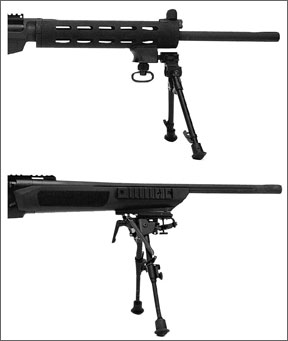
At the range we discovered the trigger was truly smooth and precise. Using a 25-pound Brownells Recording pull gauge we measured the resistance to be a consistent 3.5 pounds. Firing the Black Hills ammunition, our Fulton Armory rifle delivered an average size group of about 1.5 inches across. We thought this performance was very good considering that wind gusts up to 14 mph were at times blowing almost directly from right to left. The Federal Gold Medal rounds delivered best accuracy, averaging 0.9 inches for each 5-shot group. But we did suffer difficulty getting these groups on paper. All three choices of ammunition were jammed by the rifle or left in the magazine as the bolt failed to pick up the next rounds. Several cases were dented. Since only one magazine was supplied we couldn’t be sure if that was the cause. However, the magazine seemed to be in perfect working order and fit securely into the receiver. Short of an extractor problem, we wondered if the catch was holding the magazine properly. In view of the malfunctions, we decided not to take this gun to the 300-yard line and ceased testing once our chronograph session was complete.
Our Team Said: Too many malfunctions caused us to downgrade this rifle. If it were only a matter of a bad magazine, then this is a good example of why all guns, especially expensive ones, should be shipped with an extra magazine. But when it ran properly we think this was the best AR-10 we’ve handled. If you’re willing to fix the problem under warranty, then adjust the grading yourself.
Springfield Armory Loaded M1A No. MA9226 308 Winchester, $2363
We checked the Springfield Armory website and found nine different versions of the M1A topped by the $5278 M25 Whitefeather. Among the selection of Loaded M1A models alone we found five different configurations. Options included wood, fiberglass, or synthetic stock, carbon or stainless steel barrel and an extended cluster rail upon which to locate additional accessories. Ultimately, we chose the MA9226 that featured the new synthetic stock. Base price was $1759. With a little cash to spare we wondered if any additional options were available to enhance performance. We called Springfield Armory’s Custom Shop for handguns and asked if there was a custom rifle shop as well. The answer was yes. Improved function was supplied by installing an NM Gas Cylinder ($60). Accuracy and consistency was enhanced with glass bedding. Based on our experience with the SOCOM 16, we wanted a better way to mount the scope and create a well-coordinated cheekweld. A custom scope rail, an adaptation of the Whitefeather mount, was applied. A nylon cheek piece was firmly strapped into place. Upgrade to a match trigger was included at no extra charge.
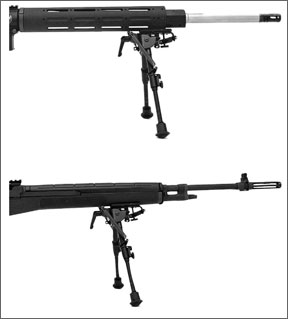
The muzzle end of the Loaded M1A showed a long thin flash hider. A front-sight assembly was in place despite the lack of a rear unit or any way to mount one. A Picatinny rail scope mount was adapted across the ejection port. The rail was approximately level with the front sight. To bring the shooter’s eye easily to the scope, the cushioned cheek piece added more than 1 inch of height to the comb. Available from the manufacturer’s website, this unit strapped on and provided excellent stability. The straps tucked out of sight so there weren’t any loose ends flapping around.
Despite these add-ons the overall profile of the rifle remained slim. The new composite stock helped the rifle handle more like a conventional hunting rifle than a military weapon. Hunters will likely favor the five-round box magazine over the 10- and 20-round models also available.
Operation was no different than the standard M1A rifle. The safety worked forward and back from inside the trigger guard. The magazine release was a vertical lever to the rear of the magazine. It was easy to grab the magazine and squeeze the release in one motion. We did notice, however, that it was easier to insert the magazine with the bolt closed. Locking back the bolt was accomplished by pressing down on the stop located on the left side of the action. However, the bolt stop did not double as a release. The only way to release the bolt was to pull it rearward and let it go. This didn’t bother us because it worked as easily as resetting the carriage on a manual typewriter.
At the range our testers measured the trigger pull to be about 5.5 pounds. This surprised us because it felt much lighter. There certainly wasn’t any slack or creep in its operation.
The Springfield fed everything we put through it, including the miscellaneous rounds we used to sight in. Firing our test rounds, the Loaded M1A showed a definite preference for the 168-grain bullets. The 175-grain rounds landed groups measuring about 1.5 inches across. But the range in group size when firing the lighter rounds varied little. All shots fired with the Black Hills 168-grain bullets printed groups of about 1.2 inches to 1.3 inches across. The Federal rounds produced a couple of 0.9-inch groups from the 100-yard line, but final average was 1.1 inches across for five shots. Shooting from prone position with a Harris bipod, accuracy at 300 yards translated to groups that read primarily in the range of 3.5 to 3.7 inches. Our best single group at this distance, however, measured about 2.5 inches across with the 168-grain Black Hills boattail hollowpoints.
Our M1A was one of the first “menu rifles” produced by Springfield Armory’s custom rifle shop. We liked the slender profile of the new composite stock. But if we intended to do more shooting supported by a bipod or sling, we would have preferred this same package specifically with the glass bedding built upon the walnut stock. The wood would have added little cost compared to the heavy fiberglass MacMillan stock (about a $500 option), and made for a more rigid unit overall. But we think the 308 ammunition was more at home firing from this platform than from our other rifles.
Our Team Said: We simply had the most faith in this rifle. The new composite stock, similar to polymer, slimmed down this rifle considerably, which helped us adapt it for the field. For prone work, we would choose the more rigid wood stock. Options from the new custom shop should increase the popularity of this classic platform.
DSA FAL SA58 No. SA58B21CM 308 Winchester, $2095
Now that just about everyone owns an AR-15, it’s become more difficult to stand out in the crowd. But dsarms.com has the answer for those who want added attention.
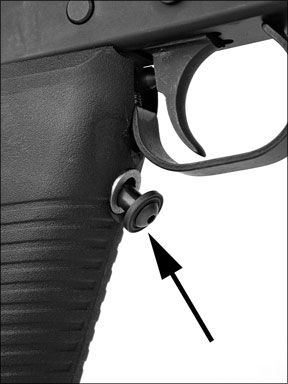
The DSA FAL SA58 exemplifies the term “black rifle,” and first-time handlers of this rifle are easily taken aback. The FAL, or Fusil Automatique Lger (Light Automatic Rifle), was originally a selective-fire rifle produced by Belgian armaments manufacturer FN Herstal during the Cold War. Our test rifle was, of course, a civilian-legal semi-automatic version. Base priced at $1850, the SA58 features a synthetic pistol grip and nonadjustable stock, an 8.7-inch-long scope rail atop an SA58 Type 1 trademarked receiver, aluminum lower, alloy free float tube (textured vented fore-end), a bull barrel, and one detachable 10-round magazine. The barrel was not finished with a compensator nor a flash hider but did offer a recessed crown.
This was the only rifle in the test with a full set of sights. The front sight was elevation adjustable by rotation. The front unit resembled a much beefier version of the AR-style front sight. The rear peep sight was adjustable for elevation by pressing in the detent button and riding it up or down a calibrated rail that sloped downward to the rear. This unit was mounted into a dovetail that allowed it to shift left or right to change windage by turning set screws mounted on either side. We could have removed the rear sight to mount our scope, but we chose to mount a Yankee Hill Machine scope riser to clear the peep sight. The peep sight accounted for about 0.6 inches in additional height.
Our SA58 was enhanced by just two options. These were a Versa Pod bipod and the SA58 Match Grade Set Trigger. The set trigger meant the rifle could be fired with a choice of two different trigger pull weights. But it wasn’t as simple as that. The set pin for the trigger was mounted on the front surface of the pistol grip. Holding the pistol grip without compressing the set pin produced a 4.5-pound trigger press. We found this press to be quite pleasing and consistent. Press in the set pin, and the following shot would be ignited after a mere 2 pounds of pressure. But this option could not be used for rapid fire. This is because each time a shot was fired using the set trigger, the pin had to be released so the trigger was able to reset. This meant a change in grip after each shot. Even after we got used to operating the set trigger, we felt that some of our attention during the controlled press was being taken up by the physical effort of pressing in the set pin. The face of the set pin was not comfortable to the naked finger either. Perhaps if we were wearing gloves, this would not have been an issue. But due to the fine nature of the set trigger, we also needed to change our grip. Using the pad of our index finger rather than catching the trigger with the first joint was the best way to take advantage of the set trigger.
Splitting the top end where reciprocating parts are located from the bottom end that housed the trigger assembly was accomplished by pressing a latch located on the left side just below the rear sight. The operating handle for working the bolt was also located on the left side. The safety was left side only and was located above and behind the trigger guard in easy reach of the right hand thumb. The magazine well was directly in front of the trigger guard and was cut away higher on the left side. The right rear corner of the magazine well was where the magazine release lever was located. The lever looked somewhat like a hammer spur upside down and the edge facing the shooter was lined for grip. On the left side of the magazine well was a pull-down lever. Pull back the bolt and push this lever upward, and the bolt was locked back. Pulling down on this lever released the bolt with authority. Like the Springfield Armory rifle we found it easier to insert the magazine with the bolt forward, action closed.
On our final day of tests, during our sighting shots at the 50-yard line we noticed some variation in point of impact that became even more pronounced when we fired from the 100-yard bench. Our initial groups were showing two distinct groups with one or two shots out of the five about 6 inches low. First, we looked carefully at how we were mounting the gun. If attention to holding in the set trigger pin was detracting from our hold, we tried a group using the standard trigger and making sure our mount was locked into our shoulder with consistent pressure at the cheek and upon the rifle rest. We dry fired to practice our hold when using the set trigger so we could benefit from its superior precision. We finally determined that the first shot of each group was the one most likely to print low. We never arrived at a definitive reason why this was happening, but we did rule out the condition of the barrel crown. We could not see any obvious rough edge or fault.
Elsewhere, we couldn’t determine if the round seated differently due to the bolt closing with less force when manually operated compared to when the action cycled. Another aspect to consider might be a pitfall shared by any semi-automatic rifle chambered for a larger caliber. The greater the available case volume, the more likely it is that the density of the powder charge was shifting away from the primer as it is moved back and force during cycling. Also, if the nose of the bullet hit the chamber wall before entering the chamber, this could push the bullet into the case and change case pressure. Also, the FAL offered variable porting for the gas operation. This is to make it possible for ammunition that produces different pressures to run the gun. Sometimes too much adjustability invites problems. But we doubt the adjustable porting was the culprit.
The above are strictly possibilities. But here is the hard data we collected. Loading six shots into the magazine our first five shots formed groups measuring on average about 4.3 inches for each choice of ammunition. With the low shot deleted we measured the average size five shot groups to be about 2.2 inches across firing the 175-grain Black Hills rounds and approximately 2.0 inches across firing the Federal 168-grain ammunition. The DSA rifle was tested last. In the off chance that the scope had become damaged and had become the cause of our problems we removed the scope and fired from the 100-yard bench using only the supplied sights. We were able to shoot a best 4.0-inch group, but we still saw a pattern of low and high hits. Based on this performance we chose not to test from the 300-yard line. Other than our difficulty maintaining consistent elevation the DSA SA58 FAL operated with complete reliability.
Our Team Said: This was a really fun gun to shoot. But despite its reliability, the lack of accuracy was frustrating. We think it is too heavy to be considered for hunting, but based on how easy it was to shoot with the supplied sights, we might try a low-mounted red dot or light variable power scope. Assuming this rifle can be refined to shoot more consistently, we’d love to own one.
0509-FNH-USA-FNAR-Light-Barreled-Rifle.pdf
0509-Fulton-Armory-Universal-Precision.pdf
0509-Springfield-Armory-Loaded-M1A.pdf





























